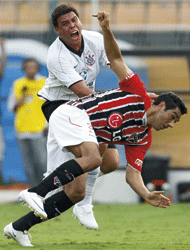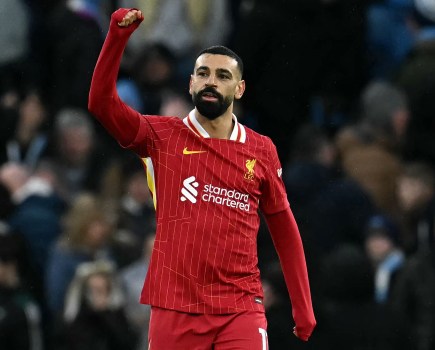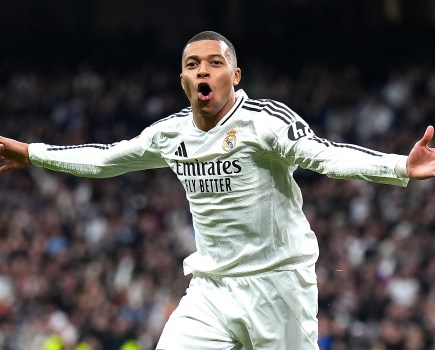Brazil’s national league, one of the world’s most closely contested championships, kicks off this weekend.
Let’s take a quick look at some of the clubs competing in the Brazilian championship.
Flamengo, Corinthians and Sao Paulo can count their supporters in tens of millions. Santos, with the Pele connection, are known all over the world and, together with Botafogo, provided the base of Brazil’s first three World Cup-wining teams.
Fluminense and Palmeiras have glorious traditions in Rio and Sao Paulo respectively; in Porto Alegre, Gremio and Internacional are huge clubs, as are the Belo Horizonte duo of Cruzeiro and Atletico Mineiro; Sport of Recife are the lions of the north and, while they may be a provincial club, Atletico Paranaense from Curitiba are full of ambition and ideas.
With this sort of strength in depth it is little wonder that the Brasileirao is one of the most open leagues in the global game. But the quantity of big clubs is not the only factor that makes the competition so hard to predict, there is a negative explanation as well: organisational deficiencies.
There is no doubting that the structure of the national championship is better than ever. Although it started in 1971 with 20 clubs, it grew and grew as the then military government responded to political pressure by inviting more and more cities to the party, and a low point was reached in 1979 when 94 clubs took part. And until recently it was generally seen as absurd for any big clubs to play in the second division, so all manner of bureaucratic pretexts were used to keep these sides in the top flight – even if they finished in the relegation zone.
Happily, all that now seems to belong to a different country. Today there is automatic promotion and relegation, fixtures are published months in advance and, since 2003, the oft-changed and frequently bizarre play-off formats have given way to a league system in which the 20 clubs face each other home and away over a seven-month period.
While this represents huge progress, one vital issue has been fudged and made even worse by the 2003 change of format – namely, the calendar.
As any European fan knows, the close season is an intrinsic part of the league campaign. A 38-game season needs a pause beforehand in which the clubs can prepare, new signings are assimilated and, crucially, the fans’ appetite for the campaign is whetted. Being deprived of the stadium experience during the close season always makes supporters anxious to return and increases their faith in the power of the new signings to make this a successful season for their club. In short, the pause in the action allows time for the magic of fandom to do its trick.
No magic, no pause
However, there is no such magic in Brazil because there is no pause. The state championships (one for each of the country’s 27 states) run from mid-January to early May – less than a week before the national championship gets under way. This means, with the vast majority of teams having been unsuccessful, that the fans are well aware of their team and its defects. Therefore the big kick off – which should be a special day in any league campaign – is depressingly low key.
Coaches can pay the price for falling short of expectations in the state competitions on the very eve of the national championship, which leaves their club forced to embark on the seven-month campaign with a caretaker boss who has been in charge for a matter of days.
Occasionally, though, it can be the case that failure in the state tournament can work in a club’s favour when the national league gets started. Last year, for example, Gremio were eliminated early on from both the Brazilian Cup and the Rio Grande do Sul state tournament, and were given little chance at national level. But having been free to have a proper pre-season, they came up with a game plan based on a well-organised defence and went very close to winning the title.
Before 2003 the year was divided into two halves in the conventional South American way, with the state tournaments running from January to June, and the national from August to December. The national has now been extended (for political reasons), while the state championships have been shortened rather than eliminated. This decision has thrown the Brazilian calendar out of sync with the rest of the world – and the consequences have been highly detrimental.
First, there is the fact that the national league begins just as the Libertadores Cup enters its knockout phase, the battle to find South America’s club champions coming to a conclusion after nine rounds of the league have been played.
This can have two effects on the Brazilian representatives in the continental competition. While they are still in the Libertadores, they usually field reserve sides for the domestic matches. Then, once they are eliminated, there is a tendency for their form to suffer. Last year both situations applied to Fluminense, who in early July were just a penalty
shoot-out away from being crowned continental champions, but in November were desperately scrambling for points to save themselves from relegation to Brazil’s second division.
Then, of course, the global transfer window opens in the middle of the campaign. Every year there is a player exodus to Europe, with some returning in the opposite direction. Players are distracted and squads are ripped apart mid-campaign. The magazine Placar publishes an excellent guide to the championship, with pen portraits of all the players, but come the second half of the season the line-ups have changed so much that a completely new guide has to be produced.
Two championships
All this turbulence arrives at a time when the matches are coming thick and fast. With no international club competitions in July and August these are the months when the league has regular midweek rounds. It is frequently said that there are two Brazilian championships: one before the transfer window and one after.
Achieving consistency in such conditions is an enormously difficult task. However, that does not mean that the destiny of the title is decided almost at random. Far from it. The shorter the competition, the greater the chance of luck playing a part.
To overcome the obstacles mentioned and to come out on top after 38 games requires structure, training facilities, medical back-up to keep players fit and in form, and planning. A successful campaign can depend on finding answers to key questions, such as which players are we likely to lose in the transfer window and how can we replace them? Who in Europe might be tempted to come back? Which good players in Brazil are coming to the end of their contract?
Obviously enough, all of this requires money. Even if a competitive squad can be assembled, history shows that form is very likely to suffer if the club is unable to pay wages on time – a frequent problem in Brazilian football.
Of late, a pattern has been emerging. Cruzeiro won the first extended national championship in 2003, but since then it has been raining titles in what is known as “the drizzly city”, with all five championships going to clubs from the state of Sao Paulo – a dominance without precedent in the competition.
Santos won in 2004, thanks to Robinho and the money from the sale of his colleagues from the title-winning team of 2002. Re-enforced by MSI’s millions, Corinthians brought in Nilmar and Carlos Tevez and were crowned champions in 2005. And Sao Paulo FC have cleaned up in the last three years, with their ultra-pragmatic model backed by the support of the elite in South America’s biggest city.
Clubs in Sao Paulo state also benefit from the continued existence of their local championship. The industrial powerhouse of a giant nation, Sao Paulo is the only state rich enough to be able to stage a worthwhile tournament and so, at the turn of the year, players who have done well in other regions tend to gravitate towards the local big four (Corinthians, Palmeiras, Santos and Sao Paulo). The trend was particularly prominent this year before the start of the 39th national championship.
Yet there could still be a challenge from the south. Internacional and Gremio both look strong, while Fluminense and Cruzeiro will enter the new campaign with high hopes.
And part of the charm of the competition is that there is always the possibility of an outsider launching a surprise bid. Nothing in the Brasileirao is ever a foregone conclusion.
For more fascinating features, subscribe and save 30% and use the below link?







